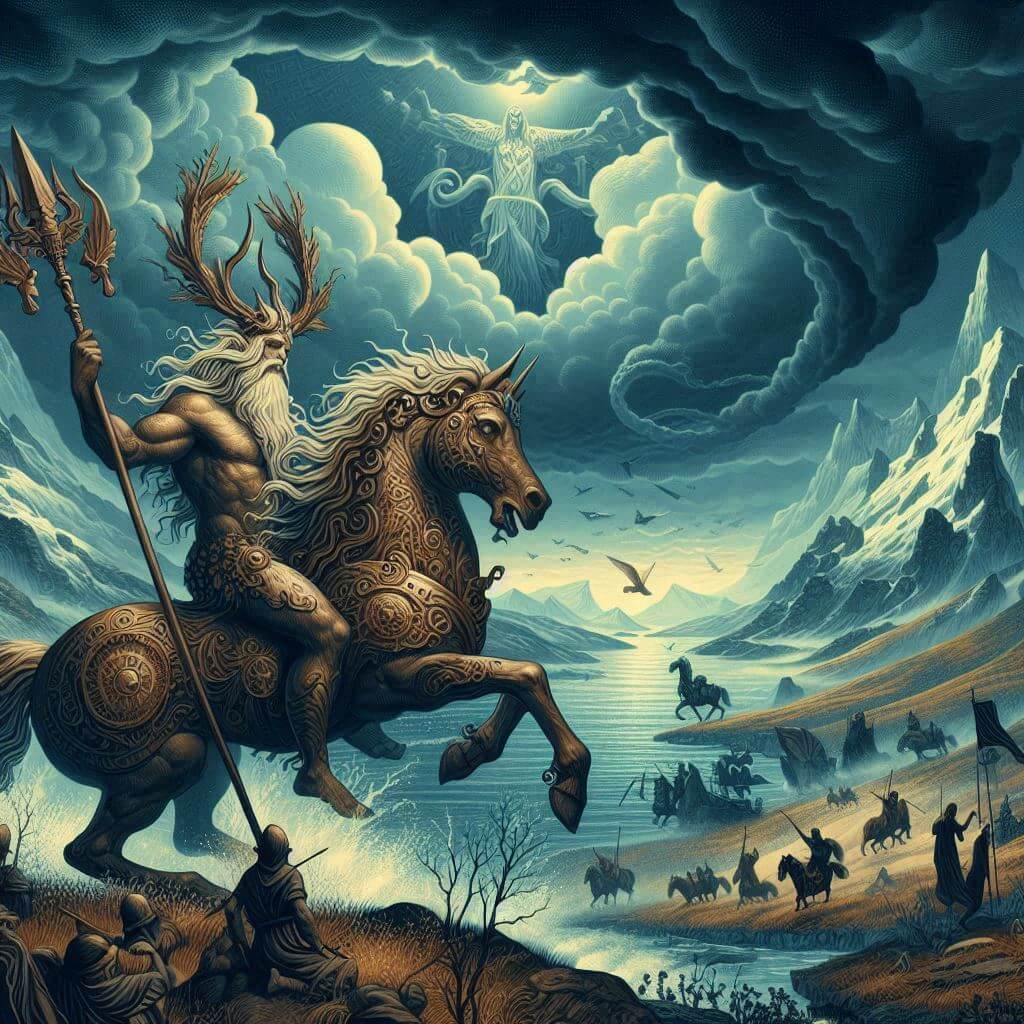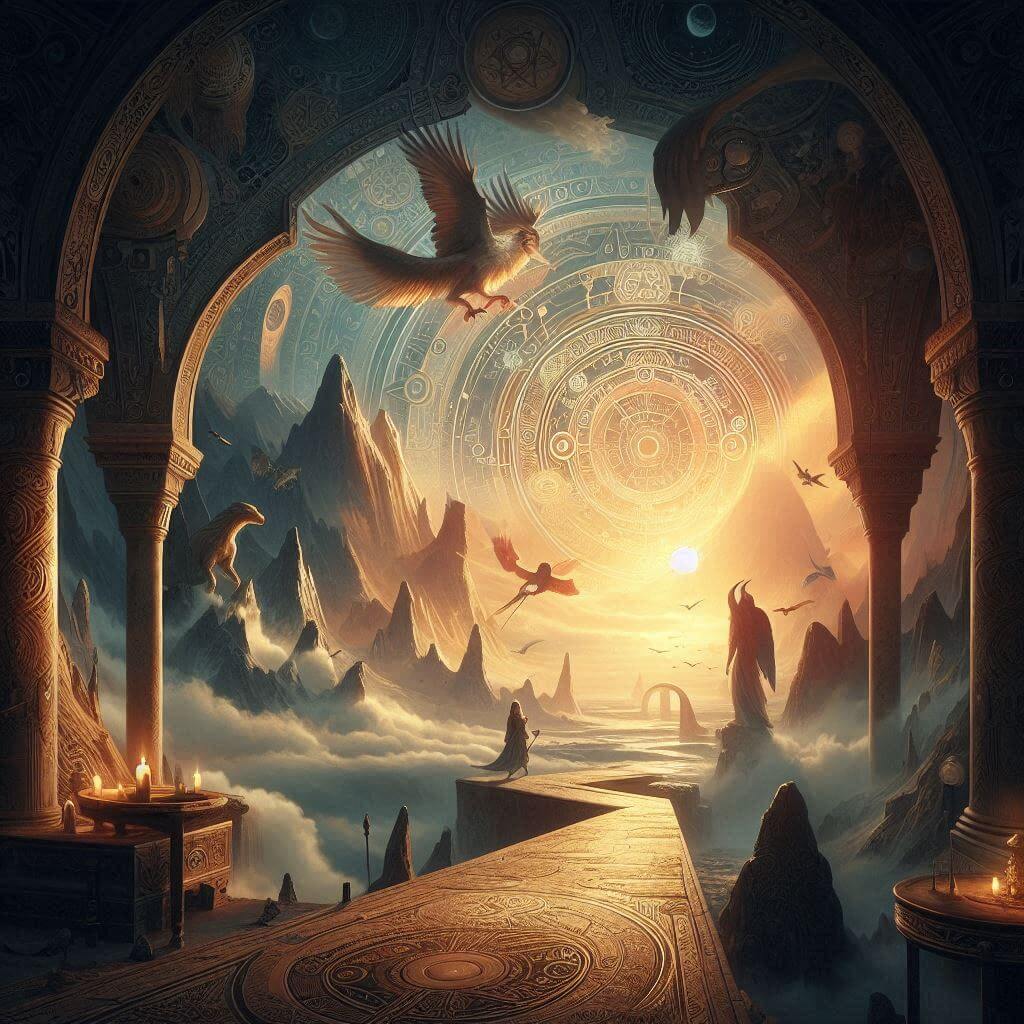Explore the mythical realm of Hyperborea, delving into ancient legends and modern interpretations. Join us on a journey through time as we unravel the enigmatic tales that blur the lines between myth and reality.

In the annals of ancient Greek geography and mythography, Hyperborea emerges as a paradisiacal oasis nestled far in the northern reaches of the world. Its inhabitants, the Hyperboreans, are said to share an intimate bond with the divine, particularly with the god Apollo and his revered cult.
The very etymology of Hyperborea’s name, ‘beyond the North,’ hints at its elusive nature, where Boreas, the god of the North Wind, reigns supreme. Yet, interpretations diverge, with some suggesting it signifies a realm ‘beyond the mountains,’ an otherworldly sanctuary hidden from mortal eyes.
But Hyperborea’s saga doesn’t merely dwell in the realms of antiquity. In the 19th and 20th centuries, it found itself resurrected, not in the dusty tomes of scholars, but in the esoteric musings of occultists and the shadowy recesses of extremist ideology.
Join us as we peel back the layers of time and delve into the mystic heart of Hyperborea, where legend and reality intertwine, and the echoes of forgotten truths resonate through the ages.
As we delve deeper into the mystical annals of Hyperborea, the tapestry of legend unfurls with ever greater intrigue. Phaeton, son of Helios, is said to have met his tragic demise in the nearby Eridanos River, his sisters, the Heliades, forever immortalized as black poplars along its banks, their tears crystallized into amber.
Yet, Phaeton’s sorrowful end is not solitary, for by the Eridanos, Kyknos, friend of the fallen youth, mourns his loss, transformed into a swan by Apollo’s empathetic hand. Here, the mythological genesis of the famed ‘swan song’ finds its roots, a haunting melody echoing through time.
In the pantheon of ancient mythology, Hyperborea stands as a beacon of paradise, its climate blessed, its proximity to the divine unparalleled. Pindar’s verses paint a portrait of a blessed people, untouched by age or ailment, devoted to the arts in fervent worship of the Muses.
Yet, Hyperborea’s gates remain elusive, accessible only to gods and heroes, mortals barred from its ethereal embrace. Perseus, among these revered few, partakes in the sacred rites of the Hyperboreans, where even the most unusual of offerings, such as hecatombs of donkeys, find favor with Apollo’s grace.
The fabled Garden of the Hesperides, home to golden apples coveted by gods and mortals alike, finds its sanctuary in the verdant realms of Hyperborea. Atlas, bearer of the celestial spheres, is said to have dwelled in the vicinity of the northern pole, his burden lightened only by the cunning of Heracles, who sought the coveted fruit.
Across the annals of history, Hyperborea transcends mere myth, becoming a canvas for utopian dreams. Hekataios of Abdera weaves a tapestry of wonder, describing an idyllic journey to the hyperborean isle of Helixoia, where two harvests flourish under the watchful gaze of the Boreades, offspring of the North Wind.
As the veils of antiquity part, revealing the enigmatic tales of Hyperborea, Herodotus emerges as our guide through the labyrinthine corridors of myth and mystery. Within his chronicles, whispers of the Hyperboreans find voice, echoing across the ages with the resonance of truth veiled in legend.
In the sacred sanctuary of Delos, where Apollo’s light illuminates the souls of believers, offerings arrive from the distant realm of Hyperborea, wrapped in wheat straw as tokens of reverence. These sacred gifts traverse a labyrinthine path, passing from hand to hand, from tribe to tribe, a testament to the enduring connection between mortal and divine.
Among the emissaries of Hyperborea, two maidens, Hyperoche and Laodike, stand as beacons of celestial grace. Accompanied by five companions, they bear not mere offerings, but the very presence of the gods themselves. In their wake, the cult of Apollo and Artemis-Eileithyia spreads like wildfire, igniting the hearts of mortals with divine fervor.
Yet, theirs is not the only pilgrimage from Hyperborea to grace the hallowed grounds of Delos. Arge and Opis, embodiments of ethereal beauty, tread the sacred soil, bearing the divine essence of the gods themselves. As Apollo’s chariot arcs across the heavens, their journey marks the dawn of a new era, where mortal and divine commune in sacred union.
In the annals of history, Hyperborea’s influence transcends mere myth, intertwining with the very fabric of religious devotion. Heroic graves, nestled amidst the sanctified shores of Delos, bear witness to the timeless bond between mortal and divine, where the echoes of hymns and the whispers of legends intertwine.

From Delos to Delphi, from Olympia to the farthest reaches of the Greek world, Hyperborea’s mythic tendrils weave a tapestry of divine communion. In the sacred groves of Olympia, where the olive trees bear witness to the passage of time, Hyperborea’s legacy endures, a testament to the enduring allure of the mystical and the divine.
As we delve deeper into the labyrinthine corridors of ancient geography, the shadowy veil of skepticism shrouds the mythic realm of Hyperborea. Various voices from antiquity, each colored by their own perspective and skepticism, paint a mosaic of contradictory accounts, blurring the lines between truth and fiction.
Herodotus, ever the skeptic, casts doubt upon the tales of Hyperborea, dismissing them as fanciful fabrications born of ignorance and superstition. Yet, even amidst his skepticism, hints of intrigue linger, as he recounts the purported origins of the prophet Abaris from this fabled land.
Strabo, echoing Herodotus’s skepticism, outright denies the existence of Hyperborea and its mythical counterparts, dismissing them as nothing more than fantastical tales spun from the fabric of ignorance.
Pomponius Mela, however, offers a tantalizing glimpse into the realm beyond the Caspian Sea, where the long-lived Hyperboreans dwell in perpetual twilight, their lives untouched by the passage of time.
Diodorus, drawing from the writings of Hecataeus of Abdera, weaves a tapestry of myth and legend, describing a land where Apollo reigns supreme, and the inhabitants, devoted to music and song, live in eternal harmony.
Pliny the Elder, less skeptical than his predecessors, paints a vivid portrait of Hyperborea, where the sun rises but once a year, and the people, untouched by strife or sorrow, live in perpetual bliss.
Yet, amidst the myriad voices and conflicting accounts, one thread remains constant—the annual offerings sent from Hyperborea to the sacred shrines of Delphi and Delos. A tangible reminder of a realm veiled in mystery, where truth and myth intertwine, beckoning forth the intrepid seeker to unravel its enigmatic secrets and commune with the divine.
The modern reception of Hyperborea is as varied and enigmatic as the ancient myths themselves, spanning from scholarly inquiry to occult speculation and fantastical literature.
In the annals of modernity, Hyperborea has often served as a symbolic representation of the far north. Abraham Ortelius, the Flemish cartographer, depicted the North Atlantic between Iceland and Greenland as the “Oceanus Hyperboreus” on his 1572 map of Europe.
Despite its mythical origins, efforts have been made to locate the land of Hyperborea in the real world. Some have speculated that Hyperborea could be identified with Britannia, with Stonehenge serving as the mythical round temple of the Hyperboreans. Others, drawing upon accounts of perpetual darkness from ancient sources, have linked Hyperborea to Thule or Scandinavia.
In the mid-20th century, Jürgen Spanuth proposed Hyperborea’s location on the Kimbric Peninsula, while Albert Joris van Windekens suggested a primitive cultural community in the Macedonian-Thracian region.
Since the 19th century, Hyperborea has been embraced by occultists as a symbol of a culture-bearing race residing in the utmost north. From Antoine Fabre d’Olivet’s speculations on human races to Helena Blavatsky’s Theosophical teachings on the Aryan race and the Hyperboreans, the myth has been woven into esoteric narratives of ancient civilizations and cosmic origins.
For Friedrich Nietzsche, the Hyperboreans symbolized solitude, sublimity, and spiritual beauty. In “The Antichrist,” Nietzsche employs the figure of the Hyperborean to underscore his own philosophical stance beyond the confines of modern society.
In fantasy literature, Hyperborea has been reimagined as a prehistoric civilization on Greenland in H. P. Lovecraft’s Cthulhu Mythos and as the setting for adventures in Ian Cameron’s “The Lost Ones” and Robert E. Howard’s Hyborian Age, home to Conan the Barbarian.
Hyperborea has also found its way into popular culture through video games like Rome: Total War and Indiana Jones and the Fate of Atlantis, as well as in music, with bands like Bal-Sagoth and Horse the Band incorporating its imagery into their work.
In essence, Hyperborea continues to captivate the human imagination, beckoning explorers of both the physical and metaphysical realms to seek its elusive truths and hidden wonders.
At its core, Hyperborea continues to capture the human imagination, beckoning explorers in both the physical and metaphysical realms to seek elusive truths and hidden wonders. Whether viewed through the lens of ancient legends, scientific research, occult speculation, or fantasy literature, Hyperborea remains a symbol of the mysterious and sublime, embodying the allure of distant lands and forgotten ages.